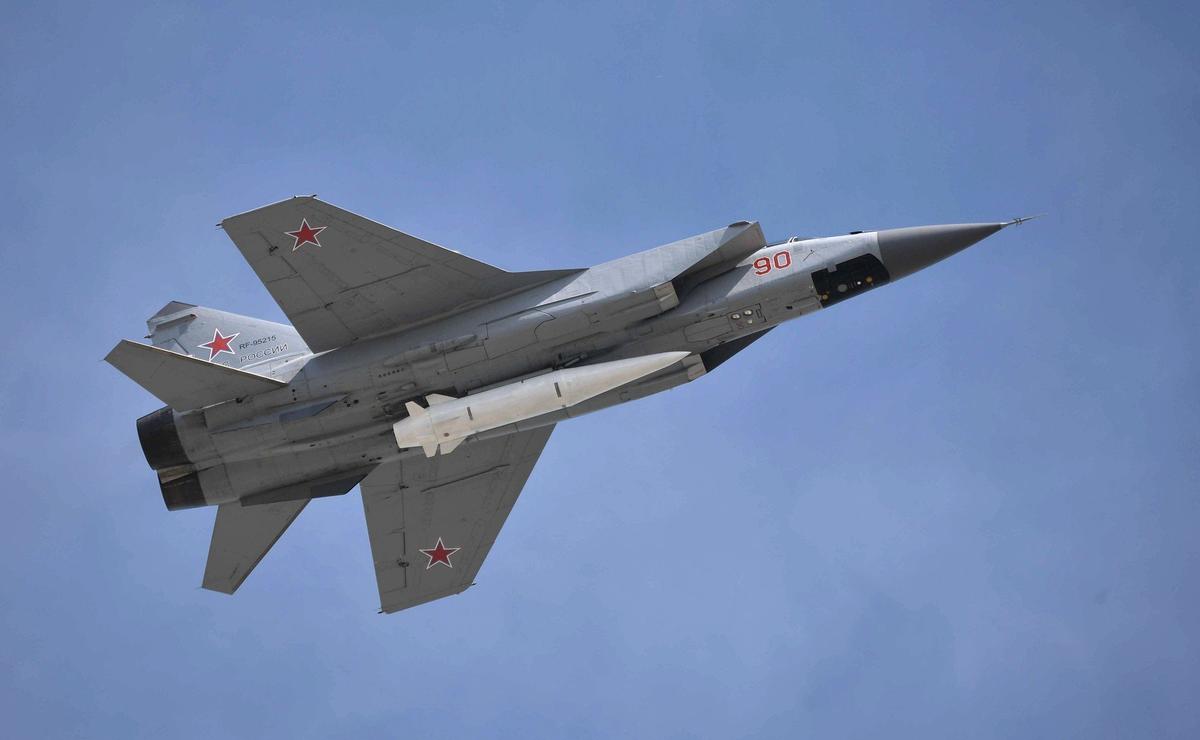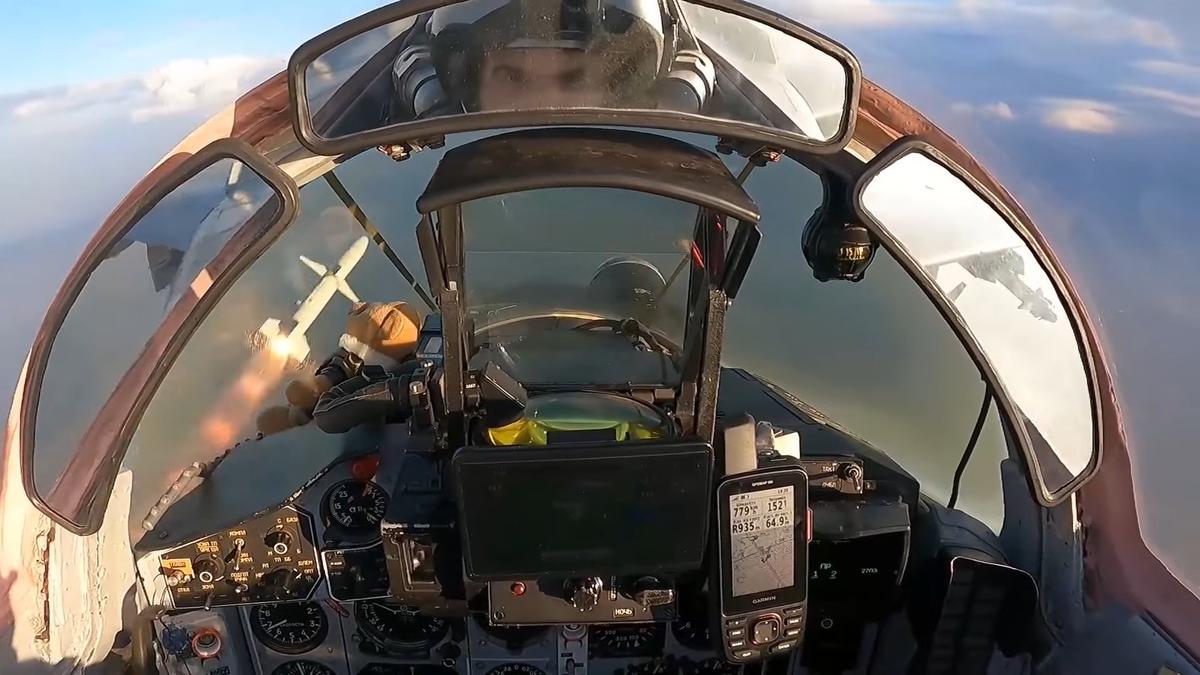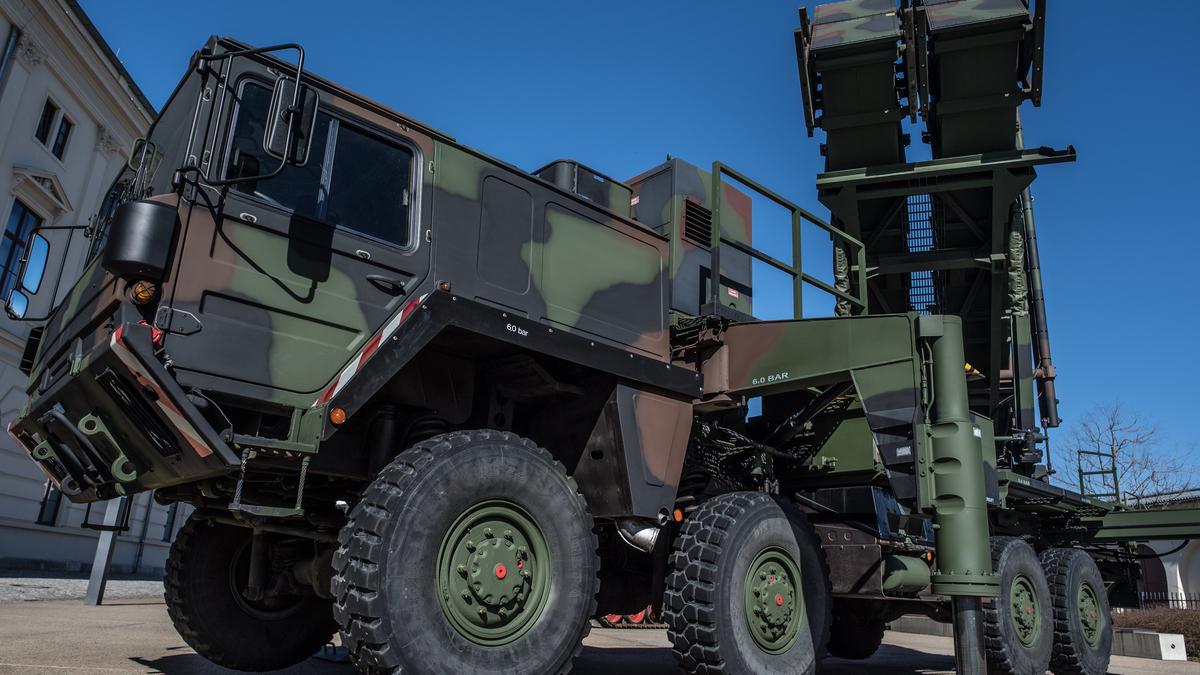Commander of the Ukrainian Air Force Mykola Oleschuk wrote on Telegram that Ukraine’s air defence was able to destroy a Russian hyper-sonic missile Kinzhal. Meanwhile, CNN reports that Russian electronic warfare systems can now deviate the High Mobility Artillery Rocket System (HIMARS) rockets off-course.
Kinzhals: no longer invincible
“I congratulate the Ukrainian people on the historic event! Yes, we did shoot down the ‘unmatched’ Kinzhal!” Mykola Oleschuk posted.
The commander of the Air Force reported that a Kh-47 Kinzhal missile, launched by a MiG-31K aircraft from the territory of Russia in the early hours of 4 May, had been shot down over the Kyiv region with the help of the US air defence system Patriot. Ukrainian media outlet Defense Express published photos of the wrecked Kh-47. This missile has never been shot down before. Kinzhal was considered to be impossible to intercept. CNN reported, citing an anonymous source, that US advisers took no part in the interception and that Ukrainians who trained in Oklahoma managed to successfully do it on their own. According to CNN’s source, the Pentagon was particularly satisfied with that fact.
In the past, Russia’s Defence Minister Sergey Shoigu claimed that Kinzhal was impossible to either “detect or intercept”. Russian authorities have not commented on Oleschuk’s statement.
“The myth about Kinzhals being invincible has been completely shattered. The use of the US Patriot systems has convincingly proven that even the most advanced Russian weapons are vulnerable to them,”
head of the Military Legal Studies Centre Oleksandr Musiyenko tells Novaya-Europe. “Ukrainian air defence systems are constantly getting stronger against all kinds of threats. There are ongoing negotiations with partners about deliveries of additional air defence systems, including Patriot and France’s anti-aircraft defence weapons SAMP-T, which will soon be on standby.”

Kinzhal missile. Photo: Wikimedia Commons, CC BY 4.0
“Kinzhal is considered to be a very difficult missile to intercept,” Ukrainian military expert and colonel in the AFU reserve Roman Svitan explains to Novaya-Europe. “However, the Patriot system is very good at completing this task. This air defence system is designed for destroying ballistic missiles. Such as Kh-47 Kinzhal, which are basically Iskander missiles but hanging off a MiG-31K. The aircraft that launches the missile from a distance of over 10,000 metres above the ground at supersonic speed acts as an acceleration part of the missile itself in this case. After the launch, Kh-47 goes up nearly to space and then flies along a ballistic trajectory. When it begins to drop from the highest point, Kinzhal gains hypersonic speed of 5-6 Machs (1 Mach equals the speed of sound). But in the dense layers of the atmosphere, it begins to slow down to 2-3 Machs, and that’s when a missile defence system can shoot it down. For that, an air defence system should be located at a distance of about 40-50 km from the estimated point of impact.”
According to Svitan, a Patriot missile self-destructs on the collision course with Kinzhal and releases a large number of small striking elements. Kh-47 Kinzhal flies into this cloud made up of thousands of fragments and breaks down in the air. The expert is convinced that Patriot and SAMP-T systems can also intercept missiles equipped with nuclear warheads, which would mean Russia has no missile weapons that can be guaranteed to strike Ukrainian targets.
Closed airspace
“The advantage of hypersonic weapons is that the defending side has no time to respond,” military observer for BBC News Russian Pavel Aksyonov tells Novaya-Europe. “The missile is flying so fast that the other side just does not have the time to use air defence against it. However, it seems that Ukrainians are receiving information about the state of airspace from Western partners. If they’re able to detect the planes carrying Kinzhals then it gives them additional, precious time. MiG-31K’s signature must be well known. If an aircraft is tracked beforehand, then there’s likely a chance to prepare for interception in advance, to have the time to calculate the possible trajectory of missiles after launch and strike them.”
According to Aksyonov, currently Kyiv could have two types of missiles for Patriot on standby: PAC-2 and PAC-3. The first type strikes its target with a cloud of striking elements, while the second collapses with the target in the air and shoots it down on account of kinetic energy. It’s unknown which type was used on the intercepted Kinzhal.
“Unfortunately, the air defence systems Ukraine currently possesses aren’t enough to cover the territory of the whole country from Russian missiles,”
Roman Svitan says. “Officially, it was reported that two Patriot systems were provided by Western partners. To completely secure the perimeter, they need three Patriot systems, with eight batteries each. Twenty-four batteries in total.”
Support independent journalism
Electronic warfare vs HIMARS
At the same time, CNN reported, citing sources, that Ukraine’s HIMARS systems “have been rendered increasingly less effective by the Russians’ intensive blocking”. Electronic jammers, used to throw off the system’s GPS, lead to rockets missing their targets, several sources familiar with the situation claimed. The decrease in efficiency of the HIMARS rockets due to Russia’s intensive blocking has forced US and Ukrainian officials “to find ways to tweak the HIMARS’ software to counter the evolving Russian jamming efforts”. CNN’s sources referred to the situation as a “constant cat-and-mouse game of finding a countermeasure to the jamming”, with Russia then having to look for ways to counter the countermeasures.

Electronic warfare system Nota. Photo: Wikimedia Commons, CC BY-SA 4.0
According to Oleksandr Musiyenko, attempts by Russian electronic warfare to tamper with GMLRS rockets installed on HIMARS and other guided munitions is a real issue. GPS satellite signals are used to guide them and they can be diverted from their set target. However, weaponry and ammunition manufacturers in the US and other countries are monitoring the situation and are constantly improving their products, updating guidance systems and their electronic maintenance. Our interlocutor also said that Ukraine is successfully hunting down Russian electronic warfare systems.
“A device that silences GPS signals at some distance is installed on important facilities,” Svitan says. “When a flying rocket or missile ends up in a zone where such devices are turned on, the external control is lost and they continue moving according to the last received coordinates. Add to that that it can be affected by wind or other objective factors. Usually, a GLMRS rocket hits the target two-three metres away from the set coordinates. In case electronic warfare systems are successful in tampering with it, a rocket can divert and strike at a distance of 10-15 metres or thereabout.”

Ukrainian MiG-29 launching an AGM-88 HARM missile. Photo: Wikimedia Commons, CC BY 4.0
Roman Svitan explains that an electronic warfare system in itself is a great target for an anti-radiation missile such as AGM-88 HARM. This weapon is directed at a source of signal and radiation which is what an electronic warfare system is. A Russian military expert who wished to remain anonymous agrees with Svitan. According to him, electronic warfare systems have serious shortcomings.
“One has to understand that electronic warfare systems jam all communication and navigation in the radius of their range,” the Russian expert says. “How to manage the troops under these conditions is unclear. They would have to use archaic wired connection, which is very ineffective during active hostilities. Furthermore, for the enemy turning on such systems is like a red flag for a bull. It immediately becomes clear that something important and valuable is located there, something that needs defending. Also, a round-the-clock use of powerful electronic warfare devices requires massive power capacity which is not always easy to supply near the frontline.”
The Russian expert adds that electronic warfare equipment is hazardous to the health of people stationed at these secured facilities. Seeing as electronic warfare is carried out at microwave, ultra-high frequencies range. The consequences of conducting it can be quite severe.
“If you hold a light bulb near a powerful device, it turns on without connecting to anything, just in the air,” says our interlocutor. “That’s how strong the radiation coming off the device is. It’s obvious that a person begins to ‘roast’ if they’re close by. But during war, not much importance is given to this factor.”
Join us in rebuilding Novaya Gazeta Europe
The Russian government has banned independent media. We were forced to leave our country in order to keep doing our job, telling our readers about what is going on Russia, Ukraine and Europe.
We will continue fighting against warfare and dictatorship. We believe that freedom of speech is the most efficient antidote against tyranny. Support us financially to help us fight for peace and freedom.
By clicking the Support button, you agree to the processing of your personal data.
To cancel a regular donation, please write to [email protected]

